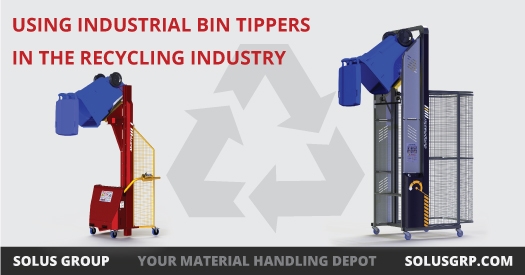We use cookies to make your experience better. To comply with the new e-Privacy directive, we need to ask for your consent to set the cookies. Learn more.
Using Industrial Bin Dumpers in the Recycling Industry
The recycling industry has long recognized the benefits of automated collection and outfitted trucks with mechanized lifting devices. The benefits of fewer worker injuries and quicker collection were too obvious for the industry to ignore.
Likewise, janitorial providers invest in bin dumpers to reduce strain on their valued staff as they empty waste and recyclables from bins to larger dumpsters. Unsurprisingly, mechanical lifting devices aren't just useful for collection routes and custodians. Once recyclables arrive at a multi- or single-stream material recovery facility (MRF), there is still quite a bit of lifting to do, and bin dumpers can help.
Bin Dumpers speed up sorting and reduce worker injuries at MRFs.
Relying on mechanical devices for emptying bins and other containers means that facilities can fill bins higher with heavier loads and empty them less frequently. Even when emptying heavy and unwieldy containers, bin dumpers keep staff safe by reducing musculoskeletal injuries.
Bin dumpers from Solus Group are available in a wide range of capacities. The Multi-Tip hydraulic tipper can handle up to 330 pounds, while the Dumpmaster can easily lift 660 pounds. Custom builds give MRFs bin dumpers with even larger capacities to deal with bales of paper and other bulky loads.

The versatility of these tippers allows MRFs to employ them anywhere heavy lifting is needed. Instead of using a worker (or two) to lift and empty large bins, bin dumpers allow one worker to safely empty a bin while their muscles have a few moments to rest and recover.
Automated sorting and lifting keep staff healthy.
In multi-stream facilities the bulk of sorting is done by hand. This means employees are constantly reaching and lifting items off a conveyor belt. While individual items are generally light, the repeated reaching and lifting can lead to musculoskeletal disorders.
Single-stream facilities tackle this problem with automation. Through the use of vibration, screens, magnets, and eddy currents, these facilities reduce the amount of staff hours needed for sorting tasks. But even in the most sophisticated MRFs that rely on chutes for sorting and removing, full bins and other large loads must occasionally be emptied. When workers must empty loads manually, risk of serious injury increases.
The Occupational Safety and Health Administration (OSHA) reminds us of simple changes that the waste collection and recycling industry can make to reduce errors, sick days and injuries during these processes. Some recommendations include:
-
Improve work station designs.
-
Adjust work posture and pace.
-
Use lifting mechanisms.
-
Rotate workers through different jobs.
Bin dumpers touch on all of these recommendations to some degree. They improve posture and pace by allowing staff to take a walking break to empty the bin. The simple and effortless task of emptying a container with a bin dumper gives a worker's muscles a well-needed break while keeping the workflow moving. Employing a bin dumper not only improves the workstation, it allows staff to rotate jobs when it's time to empty a container.
Where repeated emptying of heavy bins is commonplace, bin dumpers offer a quick return on investment.
Just as mechanical lifting devices make collection trucks safer and more efficient, bin dumpers can benefit MRFs. Bin dumpers give employees a safe way to empty large loads while giving their bodies a break from the strain of sorting and lifting.
High-quality bin dumpers use cages to ensure worker safety from falling debris and can quickly empty a bulky load with minimal strain on an employee's body. When staff can avoid dangerous movements like lifting loads over the shoulder or lifting and twisting, MRFs will see less turnover, fewer sick days, and happier employees.
References:
"Demonstration Project: Solid Waste Management and Recycling." WA. Washington State Department of Labor & Industries, Nov. 2004. PDF. 28 Sept. 2017.
"Lifting Injuries." OSHA. Occupational Safety and Health Administration, U.S. Department of Labor, n.d. Web. 28 Sept. 2017.
